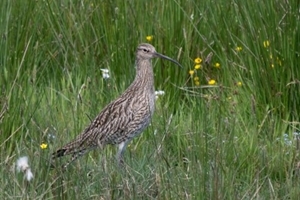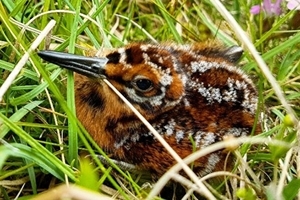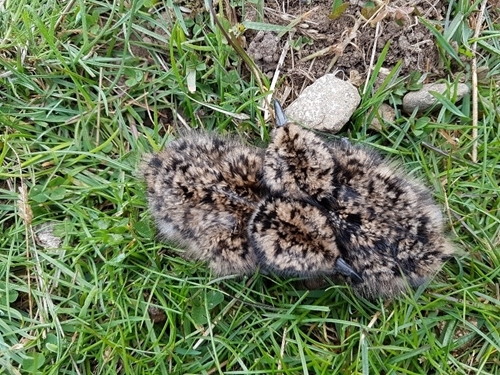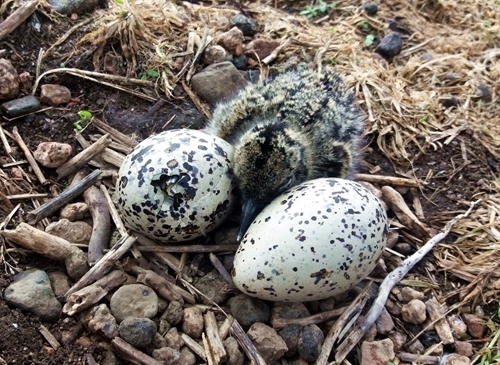The abundance of breeding waders found at Auchnerran provide a rare opportunity to study these species. We have large breeding populations of many species, including lapwing, curlew, oystercatcher, woodcock and snipe.
Curlew

The plight of the curlew, for example, has been much publicised of late. This species is one of the most rapidly declining birds in the UK, falling in number by 48% since 1995; 59% in Scotland. As the UK holds somewhere around 28% of the world population of Curlew, its fate in this country is of vital importance to the species’ persistence. Population declines are thought to be driven by the increase in agricultural intensification, resulting in habitat changes and loss and increase in predator numbers which are causing a reduced productivity of breeding birds.
The Trust is currently running the Action for Curlew appeal to raise funds that will allow us to investigate these issues in some detail and in Scotland we plan to contribute to this at Auchnerran. Our monitoring to date has found between 9-12 pairs of curlew breeding on the farm in some of our denser, sedge-rich areas, and we hope to monitor these breeding attempts in more detail. Curlew are not easy to study, being a very cryptic species, though they are also very vocal on their territories when they have eggs and young. In 2018, we began extensive curlew monitoring activities to identify nest locations and nest and chick survival rates. We also aim to GPS tag a small sample of breeding individuals. These tags frequently record the birds’ positions through the day, so we will learn lots about their use of the farm’s habitats, their time away from the nest and where they lead chicks to forage: all valuable clues as to what features of the environment are important to curlew.
Snipe
 Snipe are abundant at Auchnerran with displaying males evident most evenings through the spring and summer around our wet pastures and sedge-rich ground, but to date we have not had the resources to investigate further and determine how many pairs we have. In the future, if we can raise the funds, we would like to mirror the curlew tagging and follow some female snipe through the breeding season: this would provide some valuable details and fill gaps in our understanding of this species’ basic ecology.
Snipe are abundant at Auchnerran with displaying males evident most evenings through the spring and summer around our wet pastures and sedge-rich ground, but to date we have not had the resources to investigate further and determine how many pairs we have. In the future, if we can raise the funds, we would like to mirror the curlew tagging and follow some female snipe through the breeding season: this would provide some valuable details and fill gaps in our understanding of this species’ basic ecology.
Woodcock
Our monitoring of woodcock at Auchnerran focuses on both the breeding season and the winter. Resident woodcock in the UK have declined by 23% in the ten years between 2003 and 2013, and is an obvious cause for concern. GWCT research elsewhere is investigating this in a number of ways, but at Auchnerran it is important that we keep tabs on our local population as we modify the farm and alter field management. We hope in the future to raise funds to allow us to expand this work on our breeding birds to better understand what drives their productivity.
Our winter monitoring is equally important because we use this to ensure our small shoot does not impact on our breeding population by shooting resident birds. By conducting lamping surveys after dark from around October onwards, we can keep tabs on how many winter migrants are arriving from the continent. This is important because a controlled shoot of migrant birds is sustainable as the continental breeding populations are stable, whereas overshooting of local, resident breeders may not be. There is now a network of monitoring projects which provide information on woodcock productivity year-by-year, and further guidelines on shooting woodcock are available from GWCT.
Lapwing and oystercatcher
Lapwing are our most abundant wader at Auchnerran with around 70 pairs recorded from 2017-2019. This suggests that the large population is supported by a very high breeding-success rate, with all 20 nests monitored with camera traps in 2017 producing chicks, and on average across all breeding pairs, between 0.9 and 1.3 chicks produced per pair/nest.
We are currently looking at where the birds breed across the farm, whether nesting attempts are successful or not, and if not, what the cause of failure was, and what other resources are present in the fields, such as invertebrate food supplies. In 2018 and 2019 young lapwing chicks were radio-tagged shortly after hatching. This helps to provide further information for survival rates and productivity of individuals and of the population. In 2019, adult lapwing and curlew were GPS tagged. This will help us understand migratory patterns of the population present on the farm.

Oystercatchers share the fields with our lapwing population and together both species provide a good indication of how changes in farming practices can influence ground-nesting birds. Interestingly, in 2017 – 2019 a large number of oystercatchers were present, though very few seemed to breed. We will be monitoring this situation closely in future.
